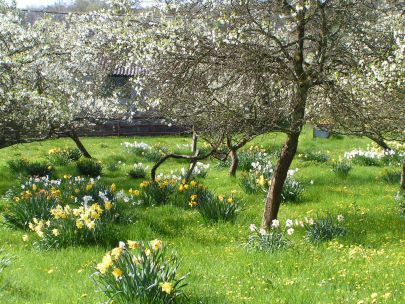Damson growing in the Lyth Valley, Cumbria
The damson crop this year has been very poor due to a slight frost and strong winds in April, however frozen damsons are available from Witherslack Community Shop.
Damson Day this year was held on the Westmorland County Showfield at J36 off the M6 and was a huge success so a big thank you to everyone who supported the event. Damson Day 2025 will be held on Saturday 12th April at the Westmorland County Showfield at J36 off the M6. Hope to see you there.
This small plum is thought to have originated around Damascus and to have been brought to this country by the Romans or the Crusaders. The Lyth Valley Damson, Prunus domestica subsp. insititia, is thought to be derived from a Shropshire prune, possibly a variety called Blue Violet. The Lyth Valley Damson is more commonly called the Westmorland, Kendal or Witherslack Damson, Westmorland having now been swallowed into Cumbria. They are now mainly grown in the Lyth and Winster Valleys.
The unique, slightly tart, flavour of the Lyth Valley Damson is thought to be a result of either crossing with Sloes, Prunus spinosa, or Bullaces, which are a type of rounder larger sloe, or evolving directly from the Bullace. Many years ago coaches came through the Valley to look at the Damson Blossom which clothed the sides of the valley. Unfortunately the orchards declined after the Second World War when there was a lack of manpower to pick the Damsons and sugar was scarce for making the jam, which was the main end product of the Damson. As the productive life of the Damson tree is only approximately 50 years, the majority of the trees left in the Valley are now declining. Fortunately there is now an awareness of the importance of preserving Britain’s orchards and new trees are being planted, with grants being available through a number of sources. Awareness is also raised through the increasing popularity of the annual Damson Day country fair held at the Low Farm in the Lyth Valley, where Damson related products are sold alongside other locally produced foods & crafts. This fair is timed, hopefully, to coincide with the blossoming of the Damson trees.

How to grow Damsons
The trees are grown mainly on the sides of the Valley where the soil is drier and sweeter, as the bottom of the Valley is too wet and acidic. They are self-fertile and need moisture retentive free draining soil and will grow in an alkaline or a slightly acid soil but dislike growing in peat. They are relatively disease free and require little maintenance. They may need lower branches removed as they need full sun. A dry spring is required for a good pollination, also no frost, as this can dramatically reduce the yield, especially immediately after pollination. Propagation is by removing the suckers which spring up around the base of the tree; these should produce fruit in 7 or 8 years. Established trees are sometimes available in the garden centre (please phone for availability if making a special journey). There are other varieties of Damsons available such as Merryweather and Early Rivers.
Damson Uses
Damsons were traditionally sold to the jam factories in Lancashire. It is also thought that the skins were used to produce a purple dye for cloth manufacturers in the 18th and 19th centuries. Nowadays they are used by several local producers for a variety of products including: jams, jellies, chutneys, beer, gin and wine. They are also used as a topping for pork pies make from locally reared rare breed pigs. They are still used locally for a range of puddings, but as they are comprised of approximately 80% stone, removing the stones can be a somewhat laborious task!
Making Damson Jam
Damsons will be ready to harvest in late summer early autumn & can easily be turned into a rich tasty jam.
- Simmer 2kg damsons with 800ml water in a large pan until soft.
- Remove the stones with a slotted spoon.
- Add 2.3kg sugar & keep stirring with a wooden spoon to dissolve the sugar. When you turn the spoon over there should be no sugar crystals visible on the back of the spoon.
- Put three or four saucers in the freezer part of the fridge. Boil the fruit mixture for 10 minutes, remove from the heat & test for the setting point by putting a teaspoon of jam on one of the saucers from the freezer. Place it back in the fridge to cool, then take it out & nudge the jam with your finger. If a skin has formed on the jam then it has set otherwise boil the mixture for another 5 minutes & test again. The juice from a lemon (which contains pectin) can be added if you are having trouble getting the jam to set. Adding a small knob of butter to the jam after you have got to the setting point will help combine any scum that has arisen during boiling.
- Leave to cool for about 15 minutes then pour into jars which have been cleaned & dried but are still hot. Fill nearly to the top & place a disc of greaseproof paper on the jam then seal with the jar lid.
- Leave to cool, give a quick wipe & add a label so that you know what flavour jam it is & when it was made. Store in a cool, dark cupboard that is dry.
- It is great on toast, with cheese or try mixing it with ginger & chilli sauce then brushing it onto the crispy skin of a roasting duck to give a bit of zing to your Sunday dinner.


